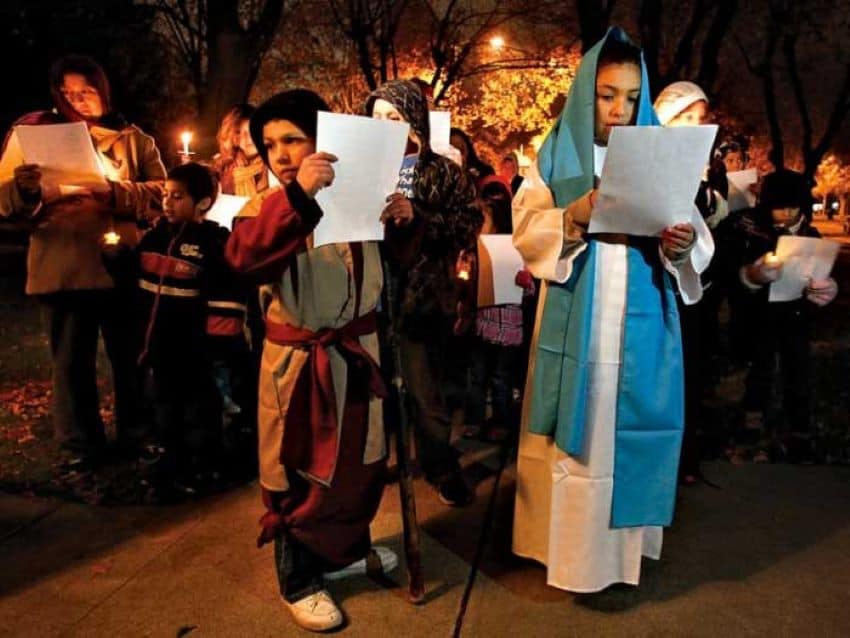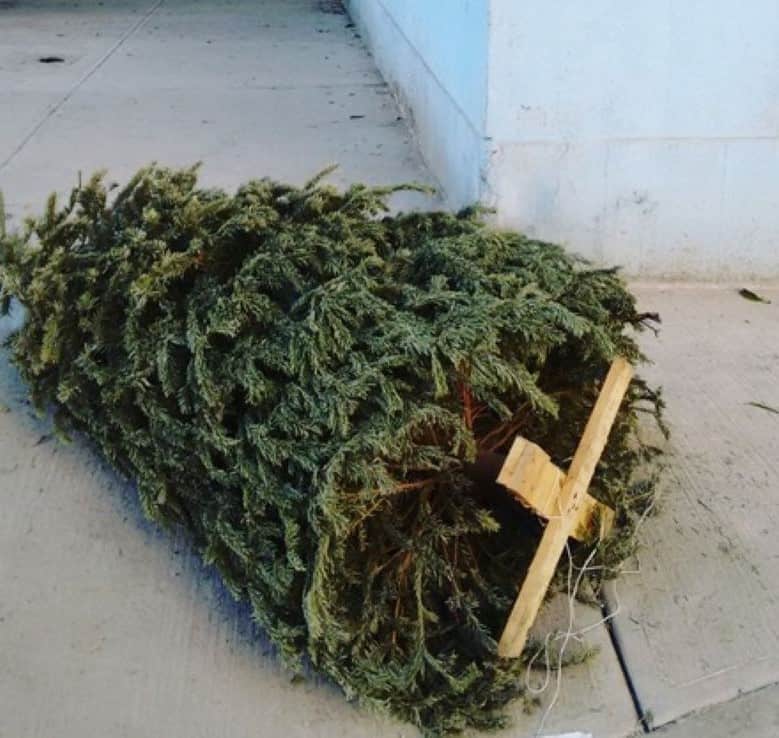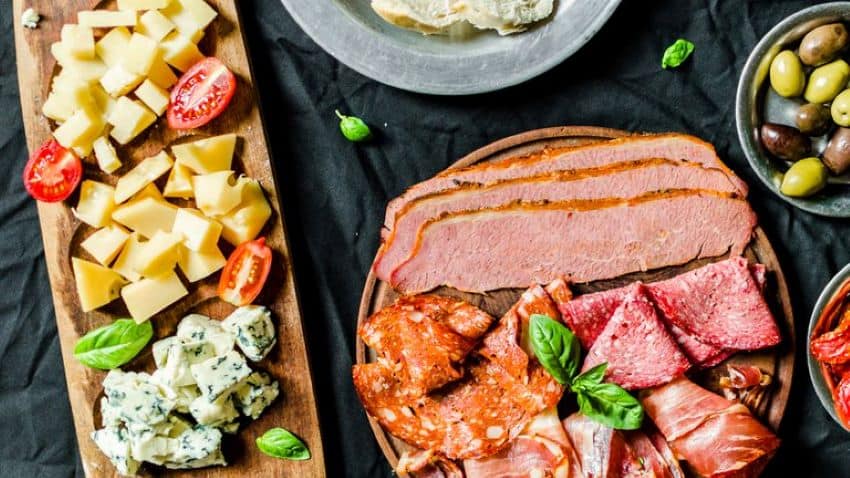On my first Christmas in Mexico, I was convinced that midnight Mass was what I needed to feel festive.
The small town where I lived had a beautiful pink-tinted cathedral that was lit up inside with enough Christmas lights, blinking at enough different speeds, that I felt I might just have an aneurysm watching them. A friend from Australia came along, and she brought a friend from London and her friend’s two parents, who were Hindu. We were quite the troop, sitting as close as we could to the back row, hoping to be inconspicuous as the only foreigners in attendance. Unfortunately for the very nervous father, he ended up at the end of the row that met with the center aisle. As passing parishioners handed out little cups of confetti, he looked at me with terror in his eyes.
“What am I supposed to do with it?” he whispered.
“Just throw it at the baby Jesus when he comes by,” I whispered back.
This provoked anxiety that I have rarely seen in a grown man. I was about to offer to switch places, but it was too late. The baby Jesus was already being carried down the aisle on his way to his mother Mary’s arms at the front of the altar. Suffice it to say, the confetti throwing from our row was a bit of a bust.
When I was a kid all I ever wanted was for each Christmas to be exactly the same as the last. The consistency – the ritual, the traditions – were all an integral part of the holiday’s joy for me. Over the years, my Christmases in Mexico have taught me to appreciate the unexpected and made me realize that surprises, good and bad, are what make the memories.

One year, Juan the butcher invited me and my then partner to a celebration known as a posada at his house just a few doors down from ours. At that point, I didn’t even really know what a posada was. The word means “inn.”
The event starts with a parade of neighbors who go from door to door, singing songs that were not unlike carols.
The pageantry reenacts the Virgin Mary and Joseph going from inn to inn in Bethlehem, looking for a place where Mary — ripe with child and tired from her journey — might rest for the night. Mary and Joseph are turned away by homes in the neighborhood several times before the last house they visit that night lets them in. Once inside, the parading troupe is greeted with piñatas and sweets and tangy, hot ponche (punch) all around with a bit of tequila tipped into the mug for adults.
Being new to the posada tradition, we were nervous about what we should bring, how we should act, but those things melted away when Juan, his wife and their half-dozen kids welcomed us with smiling faces and the heated exuberance that comes with a lively party and a little bit of liquor.
We stood at the edge of their garage, doors wide open to the street, and watched the children desperately trying to break the piñata while adults looked on with the wistful smiles of their own childhoods remembered. It was only my second Christmas away from my family — even in college I mostly made it home for the holidays — and the worry that I might feel lonely or nostalgic dissipated with the joy of those hardworking families and neighbors taking the night to just relax and revel in Christmas.
The Christmas that taught me about Mexican nativity scenes came with an invitation to help Cris and the women in her family make hundreds of tamales in a single afternoon. Each year, one family oversaw making the tamales for the Christmas pilgrims that would parade around town, and its residents had an insatiable love for them; at least three or four were needed for each person.

By the time we arrived in their village of 50 families, the corn masa was already ground and mixed, ready to be spread onto dried corn husks. All you needed to add was a smear of red or green salsa and a sliver of chicken or pork; then, presto, it went into one of the six massive steamers waiting for the holiday parcels.
A massive nativity scene had been erected in their living room a few days before. It had elements that you might imagine — the baby Jesus, Mary, Joseph, the wise men, a few farm animals — but there were also ducks, a wishing well, elephants, camels, a tiny model pigsty, a few cartoon figurines for good measure, angels, dogs and cats. All this was laid out in an undulating plain constructed from particleboard and some kind of modeling material to create hills in the scene the size of a small dining room table and covered in decorative straw. There were rivers, hills, fences and bridges. It looked more like an entire Bethlehem than the simple nativity scenes of my youth. This suddenly became one of my favorite Mexican Christmas traditions ever.
When we moved to Mexico City, Christmas lost some of its small-town charm. Instead of posadas it was the monster light displays in the zócalo that meant Christmas was here, as did images of holly and snowflakes that didn’t seem completely coherent in the heat and sunshine of the capital’s mild December.
One year, we went to see the skating rink set up in the middle of the central plaza, where millions of Mexico City kids in t-shirts waited in line for hours for their 30 minutes on the ice. In the evening it got cool enough to grab two piping hot chocolates from Sanborns and sit on the steps of the Guardiola Building, listening to a jazz quartet’s impromptu performance on Madero St., a pedestrian walkway. Shoppers were out picking up last-minute purchases, and no one could help but stop and listen to that angelic music reverberating off the colonial facades of the historic center.
Each year that I have lived in Mexico City, my favorite Christmas activity has been visiting the markets and their winding romerías — outdoor markets that sell blinding sets of Christmas lights, decorations, poinsettias and fresh-cut Christmas trees. It’s a little painful for an environmentalist like myself to see all those trees that by mid-January will decorate the curbs of the entire city as they wait to be trashed, but the smell of aisles and aisles of Douglas firs and spruce is unmistakably intoxicating. I liked to hit up the big markets for the colors but take to my local, smaller Mercado Medellín to make my final purchases. More than once I lugged a tree taller than myself on a tiny dolly the 10 blocks from the market to my house, then the four flights up to my apartment, where its tight spaces would immediately fill with the smell of pine.

Last year I spent Christmas with my parents and boyfriend in Bacalar.
“Christmas in the Caribbean!” I promised them, even though during the first several nights, we froze in the beach house, which was unprepared for anything colder than about 27 C and had no blankets.
The cold didn’t so much snap as flicker, and in a few days, it was tropical again. My mother, as our family is wont to do, brought all the traditions with her that she could, including stockings. We had no fireplace to put them on, so we hung them on curtain rods and chair backs. We tried to make our traditional sub sandwiches, but it turns out that pepper jack cheese and old-fashioned loaf are not that easy to come by in Mexico, so we made do with manchego and sliced turkey. We did succeed in watching the family classic, A Christmas Carol with George C. Scott, with a tiny portable projector and a makeshift screen made from a sheet, but sitting in our tank tops and shorts, I never felt farther away from the snowy, cold London on the screen.
That Christmas reminded me of another Mexico Christmas, years before, in a different relationship and with a different family, that I spent in Manzanillo on the Pacific coast.
It might have been the hottest Christmas I can remember (except the one I spent in Buenos Aires during their worst heatwave in 20 years). My girlfriend’s family had come from Argentina to celebrate with us, and I was insistent on getting a tree to decorate. I drove her crazy for days going from big-box store to big-box store until I found an extremely overpriced and sad-looking fake spruce.
We made ornaments with the kids, who were over the moon about the glitter and when I pulled out my mom-approved stockings in the morning, overflowing with gifts and nonsense, I was sure their heads would explode; gifts in Argentina are mainly given for Three Kings Day, and this was like celebrating twice!

We sweated out Christmas night on the patio, drinking ice-cold white wine and staying cool with a picada, an assortment of cured meats, cheese and olives, while sending Chinese floating lanterns into the air, wishing for brighter things for the New Year.
Because of Covid, I won’t be going back to the wintry north this year to see my family for Christmas. After almost a year of quarantine, the prospect of gathering around the old yule log to celebrate sounds awfully nice, but after so many Christmases spent in my adopted country, I know that there is bound to be some little detail that has yet to amaze me.
And I can count among my precious gifts this year that the people I love are at home, safe and healthy in front of their fires and that I will be enjoying Christmas in Mexico once again.
Lydia Carey is a regular contributor to Mexico News Daily.